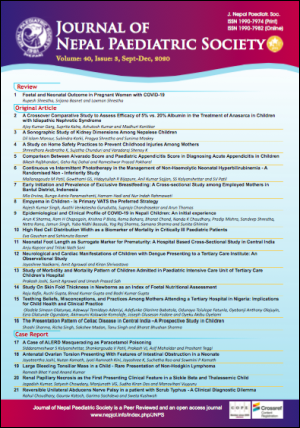Epidemiological and Clinical Profile of COVID-19 in Nepali Children: An Initial Experience
DOI:
https://doi.org/10.3126/jnps.v40i3.32438Keywords:
COVID 19; Nepal; ChildrenAbstract
Introduction: COVID-19 has spread all around the world with huge toll of human lives and suffering since it evolved in China. Nepal had slow rise in morbidity due to COVID 19 in early days but has been gripped by the pandemic's exponential growth lately. This study was conducted with the aim to describe the clinical and epidemiological features of Nepali children in early phase of the pandemic.
Methods: This was an observational study conducted at 11 COVID care centres designated by the Government of Nepal with availability of supervision by paediatricians between January and August 2020 in children under 18 years of age diagnosed with COVID 19. Data was collected based on definitions outlined in data collection resources available at WHO-ISARIC Global COVID-19 clinical resources platform and analysed.
Results: One hundred and twenty one children diagnosed with COVID 19 who presented to the designated centres were enrolled. Majority of children (83.4%) were identified as a part of contact tracing, 28.1% had an identified contact to a person with COVID 19 prior to their diagnosis and 20.7% had another household member diagnosed with COVID 19. The mean age of admitted children was 8.8 years (SD 5.6 years) with the largest proportion being adolescents (40.5%). Male (58.7%) children were more commonly affected. There were 15 (12.4%) infants and 8 (6%) of them were under two months of age. Most children (87, 71.9%) were asymptomatic, 21 (22.3%) had mild symptoms and six (4.9%) had moderately severe symptoms. Fever (18.2%) was the most commonly reported symptom. All children were discharged after a median of 14 days of hospitalisation.
Conclusions: Nepali children of all ages are affected by COVID 19 and present with asymptomatic or mildly symptomatic infection. Fever and respiratory symptoms are the most commonly reported symptoms. Most children do not develop complications. Continued surveillance in larger population of children as the pandemic unfolds will generate more stringent observations.
Downloads
Downloads
Published
How to Cite
Issue
Section
License
Authors who publish with this journal agree to the following terms:
Authors retain copyright and grant the journal right of first publication with the work simultaneously licensed under a Creative Commons Attribution License that allows others to share the work with an acknowledgement of the work's authorship and initial publication in this journal.
Authors are able to enter into separate, additional contractual arrangements for the non-exclusive distribution of the journal's published version of the work (e.g., post it to an institutional repository or publish it in a book), with an acknowledgement of its initial publication in this journal.
Authors are permitted and encouraged to post their work online (e.g., in institutional repositories or on their website) prior to and during the submission process, as it can lead to productive exchanges, as well as earlier and greater citation of published work (See The Effect of Open Access).



